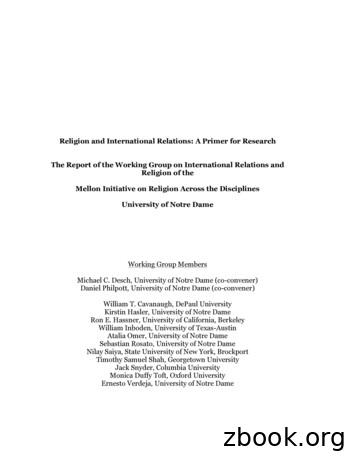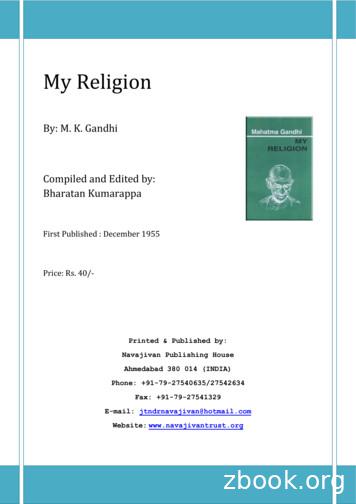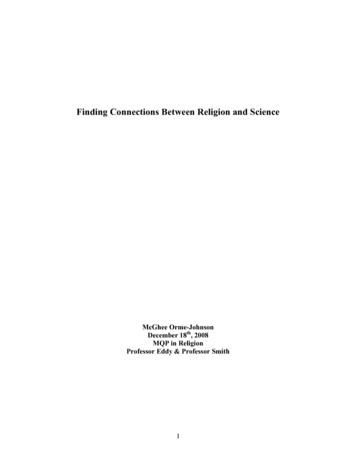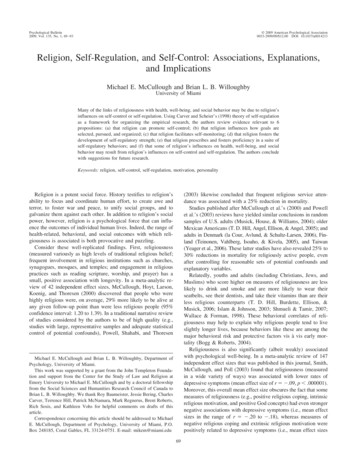Religion And International Relations: A Primer For .
Religion and International Relations: A Primer for ResearchThe Report of the Working Group on International Relations andReligion of theMellon Initiative on Religion Across the DisciplinesUniversity of Notre DameWorking Group MembersMichael C. Desch, University of Notre Dame (co-convener)Daniel Philpott, University of Notre Dame (co-convener)William T. Cavanaugh, DePaul UniversityKirstin Hasler, University of Notre DameRon E. Hassner, University of California, BerkeleyWilliam Inboden, University of Texas-AustinAtalia Omer, University of Notre DameSebastian Rosato, University of Notre DameNilay Saiya, State University of New York, BrockportTimothy Samuel Shah, Georgetown UniversityJack Snyder, Columbia UniversityMonica Duffy Toft, Oxford UniversityErnesto Verdeja, University of Notre Dame
Table of ContentsPart One: Introduction1. “Introduction” . . 62. Michael C. Desch, “The Coming Reformation of Religion in InternationalAffairs? The Demise of the Secularization Thesis and the Rise of New ThinkingAbout Religion” . 14Part Two: What Is Religion and How Does It Shape International Relations?3. William T. Cavanaugh, “What is Religion?” 564. Ron E. Hassner, “Religion as a Variable” . 685. Daniel Philpott, “The Religious Roots of International RelationsTheory” . 766. Timothy Samuel Shah, “Religion and International Relations: NormativeIssues” . 877. Ernesto Verdeja, “International Political Theology” . . 103Part Three: What Are Religion’s Most Important Manifestations in InternationalRelations?8. Atalia Omer, “Religion and Nationalism: What’s the Link?” . 1119. Kirstin Hasler, “International Relations Theory and Nationalism: Any RoomFor Religion?” . 13310. Monica Duffy Toft, “Religion and Civil Wars: Next Steps?” . 14211. Nilay Saiya, “Religion and Terrorism: What Remains to be Said?” 15212. William Inboden, “Religion and International Relations: How Should PolicyMakers Think About Religion?” 163Part Four: Conclusions13. Sebastian Rosato, “The Sufficiency of Secular International RelationsTheory” . 1762
14. “Conclusion” . 1843
Members of the Working GroupWilliam T. Cavanaugh is Senior Research Professor at the Center for WorldCatholicism and Intercultural Theology at DePaul University. His most recentbooks are The Myth of Religious Violence: Secular Ideology and the Roots ofModern Conflict (Oxford, 2009) and Migrations of the Holy: God, State and thePolitical Meaning of the Church (Eerdmans, 2011).Michael Desch is Professor of Political Science at the University of Notre Dameand author most recently of Power and Military Effectiveness: The Fallacy ofDemocratic Triumphalism (Johns Hopkins, 2008).Kirstin Hasler is a graduate student at the University of Notre Dame,specializing in international relations. Her dissertation focuses on the role ofnationalism in combat effectiveness.Ron E. Hassner is Associate Professor of Political Science at the University ofCalifornia, Berkeley. His most recent books are War on Sacred Grounds(Cornell, 2009), and Religion in the Military Worldwide (Cambridge, 2013).William Inboden is Assistant Professor at the LBJ School of Public Affairs andExecutive Director of the Clements Center for History, Strategy, and Statecraft atthe University of Texas-Austin.Atalia Omer is Assistant Professor of Religion, Conflict, and Peace Studies atthe Kroc Institute for International Peace Studies and a faculty fellow at theCenter for the Study of Religion and Society, both at the University of NotreDame. Her most recent books are When Peace Is Not Enough: How the IsraeliPeace Camp Thinks about Religion, Nationalism, and Justice (University ofChicago Press, 2013) and Religious Nationalism: A Reference Handbook (ABCCLIO, 2013).Daniel Philpott is Professor of Political Science and Peace Studies at theUniversity of Notre Dame and author most recently of Just and Unjust Peace: AnEthic of Political Reconciliation (Oxford University Press, 2012).Sebastian Rosato is Associate Professor of Political Science at the University ofNotre Dame. He is the author of Europe United: Power Politics and the Makingof the European Community (Cornell University Press, 2011).Nilay Saiya is Assistant Professor of Political Science and Director ofInternational Studies at the State University of New York, Brockport. He isinterested in the role of religion in foreign policy making and religious violence.Timothy Samuel Shah is Associate Director of the Religious Freedom Projectat the Berkley Center for Religion, Peace, and World Affairs and Visiting4
Assistant Professor in the Government Department, Georgetown University. Heis the author most recently of Religious Freedom: Why Now? Defending anEmbattled Human Right (Witherspoon Institute, 2012).Jack Snyder is the Robert and Renée Belfer Professor of InternationalRelations in the Political Science Department and the Saltzman Institute of Warand Peace Studies at Columbia University. His books include Religion andInternational Relations Theory (Columbia University Press, 2011); Electing toFight: Why Emerging Democracies Go to War (MIT Press, 2005), co-authoredwith Edward D. Mansfield; and Myths of Empire: Domestic Politics andInternational Ambition (Cornell University Press, 1991).Monica Duffy Toft is Professor of Government and Public Policy at theUniversity of Oxford’s Blavatnik School of Government. She is the author of sixbooks and is currently writing a book on the role of religion in motivating leadersin politics and finishing a series of articles on Islamist violence, insurgency, andcounterinsurgency in the Caucasus since 1990.Ernesto Verdeja is Assistant Professor of Political Science and Peace Studies atthe University of Notre Dame and author of Unchopping A Tree: Reconciliationin the Aftermath of Political Violence (Temple University Press, 2009).5
IntroductionOver the past decade-and-a-half, the academic study of religion andinternational relations has sprouted from a sparse scattering of works into avibrant body of scholarship. The Working Group on International Relations andReligion, funded by a grant from the Mellon Foundation to the University ofNotre Dame, met four times over two-and-a-half years to assess this trend, askinghow far scholarship on religion and international relations has come and where itmight go. The group’s task, though, was not merely to explore the existingliterature but also to engage broad questions: What is religion and how has itshaped the international system of states and international relations theory?And, how is religion most importantly manifested in contemporary internationalrelations?The resulting report offers insights for all who are interested in researchon religion and international relations, whether they are scholars, students,practitioners, or general readers. The report’s center of gravity lies in politicalscience, with ten of its thirteen contributors hailing from this field, but alsomanifests disciplinary breadth. One contributor is a theologian, William T.Cavanaugh, who is one of the past decade’s most innovative and provocativescholars of religion and its relationship to politics, violence, and the nation-state.Atalia Omer, one of the leading young scholars in the field of religious studies,both engages the work of political scientists in this area and points to pathways ofinquiry in other disciplines. William Inboden, a historian and a former U.S.foreign policy official, has pioneered the connection between religion andinternational relations in these other realms. Even the political scientists include6
political philosophers, empirical scholars, and those who combine theseapproaches. The ensuing reflections, then, entail diverse methodologies, anglesof inquiry, substantive emphases, and viewpoints, sometimes manifestinginteresting disagreements among one another.Michael Desch, one of the working group’s two co-conveners, leads offwith an essay that explores the rise of “new thinking” on religion andinternational relations. A body of scholarship on the subject has emerged, heagrees, but it remains marginal in the political science subfield of internationalrelations. Behind this marginalization is the persistent power of thesecularization thesis, which holds that religion is irrational, inherently violent,and doomed for extinction, and which has dominated not only internationalrelations research but also the western academy until recently. Desch argues thatthe secularization thesis is dead wrong, allies himself with a growing group ofcritics of the thesis, and offers fresh research that refutes it. He identifies andassesses the promise of three waves in the new scholarship on religion andinternational relations.The next five essays, constituting Part Two of the report, focus onfoundational issues in research on religion and international relations, revolvingaround the questions, What is religion?, How ought we to conceptualize religion’sinfluence?, and How has religion shaped the assumptions and theories thatunderlie international relations?If scholars of religion and international relations are to proceed aheadwith their research, they need to clarify what they mean by religion, right? Well,it is not so easy, argues William Cavanaugh. Most scholars of international7
relations think that religion is easily identified and defined, Cavanaugh pointsout. He sets forth a useful typology of these meanings. He is skeptical, though,that a transhistorical, transcultural definition of religion—a genus of which thereare species—can be found. Does this mean that we should discard the concept?No, he answers. Rather, we should recognize that religion has been constructedby modern people (that is, since the 17th and 18th centuries) and often with thepurpose of marginalizing traditions like Christianity and Islam from other areasof life like politics, economics, and culture. Rather than treating religion assomething simply found “out there” in the world, scholars should ask what kindsof power are involved in constructing certain things as “religious” and otherthings as “secular” or “political.” Ron Hassner also takes up the issue of howscholars ought to conceptualize religion in their research, focusing on religionand violence in particular. Typically, he argues, international relations scholars“conceive of religion as a deviant and irrational set of ideas that propel radicalnon-state actors into conflict.” Hassner questions, though, whether scholarsought to conceive of religion as a set of ideas at all and proposes looking atreligion in terms of symbols, practices, rituals, social structures, and discourses.Thinking about religion in this way, scholars could escape their confinement toviewing religion as a set of ideas and reasons that cause war and couldunderstand better religion’s more pervasive influence on how, when, and wherewar is fought.Another conceptual issue is religion’s role in shaping the most prominenttheories of international relations, realism and liberalism. The skeptic will objectthat neither theory has much to say about religion at all. Such an objection is8
borne of amnesia, argues Daniel Philpott, for religion’s absence in thesetraditions arises from its founders’ engagement with—and rejection of—religion.Machiavelli and Hobbes, Locke and Kant wrote at a time when the internationalsystem was being formed through a secularizing set of events. These thinkersboth applauded this secularism and built it into their explanation of the behaviorof states. This secularism has endured in these theories and explains why theyhave not performed well in describing the resurgence of religion.Timothy Samuel Shah continues this focus on how religion has shaped theinternational system by focusing on normativity. He argues that religion hascontributed to the moral and legal norms that characterize the internationalsystem. Historically, religion shaped the sovereign states system, just war norms,and the global humanitarian ethic. Religion has also propelled key historicalshifts that have given form to modern international relations: the rise ofErastianism (state control of religion) through the religious wars, the rise of thenation, and the genesis of the UN system of the mid-twentieth century. Globallyshared values that may appear both secular and taken for granted, Shah shows,have behind them the shaping hand of religion.No discussion of the theoretical foundations of research on religion andinternational relations can ignore one concept in particular: political theology.Dating back at least to Augustine, the concept has been used by theorists in agreat variety of ways, Ernesto Verdeja explains, ranging from thinkers in theEnlightenment tradition like John Rawls and Jürgen Habermas, who haveviewed theology as antithetical to core liberal political values (though Habermashas softened his stance in recent years) to theologians like Johann Baptist Metz9
and Jürgen Moltmann, who construed political theology in terms of an activistagenda that included nuclear disarmament and environmental protection.Verdeja conducts a helpful and concise tour of these meanings that concludeswith a discussion of perhaps the most famous theorist of political theology: CarlSchmitt, the early twentieth century German political philosopher who sawmodern politics as a secularized version of Christian theology.The ensuing five essays, constituting Part Three, build on these conceptualfoundations and explore more particular manifestations of religion ininternational relations. They look at religion’s relationship to nationalism, civilwar, terrorism, and American foreign policy.Atalia Omer introduces this section with a theoretically deep essay onreligion and nationalism. She begins with an exploration of what role religionhas played in three major schools of theory in the study of nationalism:modernist, ethno-symbolist, and primordialist. She continues on to offer acritique of how contemporary international relations theory frames therelationship between religion, nation, and state. The study of religion,nationalism, and international relations, she argues, is advanced best by rejectingthe notion of religion (and state, and nation) as being an unchanged historicalessence and instead theorizing the boundaries of religion and politics asinterpenetrating, ever shifting, and strongly dependent upon power relations.Kirstin Hasler continues the discussion of religion and nationalism in thestudy of international relations by focusing on contemporary internationalrelations theory. It was not until the end of the Cold War, she points out, thatinternational relations theorists made serious efforts to integrate nationalism10
into their analyses. Realists have conducted most of this integration, graftingnationalism into its core concepts of power, threat, and security dilemma. Suchgrafting, however, gives little play to nationalism’s influence as an idea and asource of identities, dynamics that the realist framework does not easily contain.It is here where religion most fruitfully enters into the analysis insofar as itsometimes shapes the character of nationalism and sometimes transcends it.The next piece, by Monica Duffy Toft, looks at one of the major sites wherereligion causes and influences violence: civil wars. Religious civil wars are moredestructive than other civil wars, she reports, rooting her explanation in religion’sdistinctive character and how it plays out in domestic and international politics.At the domestic level, Toft stresses the interplay between religious actors andstates, including that of secular governments, as critical to the maintenance ofpeace or the onset of violence. At the international level she highlights howreligion—its associated ideas, people and networks—transcends boundaries andthereby challenges the contemporary international order of states. She points outthat existing international relations theory is ill equipped to explain thesedimensions of religion—a common theme that emerges among the essays in thisreport.Nilay Saiya explores the other major form of religiously inspired violence:terrorism. Echoing the other essays, he points out that scholarship on religiousterrorism has not markedly increased even as religious terrorism itself has grownrapidly in the past three decades. He surveys what we know about religiousterrorism, including what makes it distinct, what it has in common with secularterrorism, and its tendency to be more lethal and long-lived than secular11
terrorism. He then lays out five pathways for future research, urginginternational relations scholars to take religion far more seriously.William Inboden concludes Part Three with a piece on religion and foreignpolicy. He focuses on American foreign policy, but much of what he has to saywill pique the interest of foreign policy makers in any country. The Americanforeign policy establishment, he claims, shares western elites’ commitment to thesecularization thesis and their attendant “allergy to religion.” This malaiseinhibits their analysis but also causes them to miss opportunities for marshalingreligion salubriously for foreign policy ends. He makes his case with respect toseveral categories of analysis, including anthropological, public diplomacy,conflict and reconciliation, economic development, governance anddemocratization, and religious freedom, this last one being that to which hedevotes the most attention. Were foreign policy makers to take seriously theresearch for which the other authors of this report are calling, he argues, theywould discover priceless assets for their endeavors.Sebastian Rosato graciously agreed to serve as an in-house critic in theworking group, being tasked to hold the others’ arguments to the fire and servingto remind us why many international relations scholars remain skeptical ofreligion’s influence. In his view, the emergent body of literature on religion andinternational relations falls short in three ways. First, it has failed to show thatincorporating religion would affect the way that leading traditions explainoutcomes in international relations. Second, it has failed to show that religionhas a causal effect on international political outcomes. Third, the scholars in thisarea have not ruled out alternative, non-religious explanations for the12
phenomena that the scholars claim to explain. For those interested in researchon religion and international relations, Rosato poses challenges to confront.The report concludes by outlining directions for future research.13
The Coming Reformation of Religion in International Affairs?The Demise of the Secularization Thesis and the Rise of NewThinking About ReligionMichael C. DeschIntroductionOver the last forty years, the world has been getting religion in a big way.Beginning with Israel’s seemingly “miraculous” victory in the June 1967 Six-DayWar, which brokered the marriage between Zionism and Religious Orthodoxy inIsrael, and continuing through the 9/11 attacks on the United States, the result inpart of the post-1967 events in the Middle East, religion has increasingly been acentral factor in relations within, and especially among, states.As with so many other things, however, scholars have been slow torecognize that religion remains an important factor in world politics, particularlyoutside the European world, and to grapple with the challenges of bothcomprehending how religion shapes that world and also understanding what roleit ought to play in contemporary United States foreign policy. Timothy Shahnotes this striking puzzle: “religion has become one of the most influential factorsin world affairs in the last generation but remains one of the least examinedfactors in the professional study and practice of world affairs.”1The root of this puzzle lies in the dominance of the “secularizationthesis”—the view that as the world modernizes, religion will, in Marx’s famousTimothy Samuel Shah, “Introduction: Religion and World Affairs: Blurring the Boundaries” inTimothy Samuel Shah, Alfred Stepan, and Monica Duffy Toft, eds., Rethinking Religion and114
phrase about the state, “wither away”—in contemporary social science, includinginternational relations. But while elements of the secularization thesis remaininfluential, there is a growing realization that it is both internally inconsistent (itholds both that religion is fading but that it has been, and remains, a source ofwar and other international problems) and increasingly passé. Most of the world,for most of history, has been characterized by a thorough interpenetration ofreligion and other aspects of society so that today’s global resurgence of religionis actually better characterized as a return to business as usual. The combinationof a grudging intellectual realization that social science needs to deal withreligion, in combination with dramatic examples of religion reasserting itself intointernational politics, is starting to put religion back on the intellectual and policyagendas.2To be sure, there is already a literature on religion and global politics thatoffers some conceptual and theoretical signposts pointing the way to a deeperand more nuanced understanding of religion in global politics, but thus far it ismarginal in the larger field of international relations. The result, as Monica DuffyToft observes, is that “traditional international relations theory provides littleguidance for those needing to understand the interplay of religion and politics ina global setting.”3 Unfortunately, recent theoretical and conceptualdevelopments in this literature pose challenges that may continue to keepEva Bellin, “Faith in Politics: New Trends in the Study of Religion and Politics,” World Politics,vol. 60, no. 2 (January 2008): 315 and 319. Also see Shah, “Introduction” in Shah, Stepan, andToft, eds., Rethinking Religion and World Affairs, 1.3 Monica Duffy Toft, “Religion and International Relations Theory,” in Handbook ofInternational Relations (Oxford: Oxford University Press, 2012), 673.215
religion on the margins of international relations theory and American foreignpolicy.This essay explores these challenges by, first, considering thesecularization thesis and its discontents in contemporary international relationstheory. Next, it traces three recent waves of theorizing about religion and globalpolitics. Like waves rolling into a rocky cove, they did not come in smoothsequence but rather ran together and continue to slosh about. At times, the samescholar surfs on different waves. The first of these waves looked at religion’sresidual legacy in secular international relations; the second, at the causes andconsequences of the global resurgence of religion in terms of the numericalspread of belief and the greater incidence of religiously motivated events; thethird wave, in contrast, focuses on a more conceptual aspect of the resurgence ofreligion: the growing challenge to the notion that religion is a distinct socialelement that can be separated from the other factors shaping global politics.Taken together, these three waves are eroding the grip of thesecularization thesis and making a strong case for a greater role for religion ininternational relations theory and as a factor in practical statecraft. This isespecially striking in the case of the third wave, which advances arguments aboutthe indistinguishability of religion and other factors in international politics.While these arguments may be descriptively accurate, they nonetheless posenettlesome methodological and analytical challenges that may ultimately hinderefforts to give religion the greater role in our thinking and practice whichcontributors to the burgeoning literature on religion and global politics wouldlike to see.16
The Secularization Thesis and Its Discontents In International RelationsAt its most basic level, secularization means that “religion is becoming lessimportant in the world.”4 Secularization, in this view, is one of the hallmarks ofmodernity. “There is universal agreement,” observes Rodney Stark, “thatmodernization is the causal engine dragging the gods into retirement.”5 Thereare three specific elements of the secularization thesis: First, it maintains thatthere is an increasing distinction between the “religious” and “secular realms.”Second, religious belief becomes most appropriately consigned to the privatesphere. Finally, this privatization of religion is the sine qua non of liberaldemocracy.6 Philip Gorski helpfully clarifies that the secularization thesis isactually a family of distinct theories that range from those emphasizing thedecreasing prevalence of belief to those highlighting the eroding boundariesbetween the secular and the profane.7The secularization thesis dominates American social science moregenerally, but it is particularly well ensconced in international relations. Thereason is that the field, as Jonathan Fox argues, literally had its origins “in therejection of religion” after 1648 and it remains a largely secular enterprise to thisJonathan Fox, “Religion as an Overlooked Element in International Relations,”International Studies Review, vol. 3, no. 3, (2001): 53-74. For a similar definition see DanielPhilpott, “The Challenge of September 11 to Secularism in International Relations,” World Politics55, no. 1 (October 2002):69.5 Rodney Stark, “Secularization, R.I.P.,” Sociology of Religion, vol. 60, no. 3 (1999): 251. Also seePhilpott, “The Challenge of September 11 to Secularism in International Relations,” 81.6 Jose Casanova, “Rethinking Public Religions” in Shah, Stepan, and Toft, eds., RethinkingReligion and World Affairs, 25.7 Philip S. Gorski, “Historicizing the Secularization Debate: Church, State, and Society in LateMedieval and Early Modern Europe, ca 1300 to 1700,” American Sociological Review, vol. 65, no.1 (Feb. 2000): 141.417
day. 8 There is a consensus on this among both skeptics about a greater role forreligion9 as well as critics of the field’s largely secular bent. As Jack Snyder putsit, “the main canonical works of international relations theory, which continue toshape much empirical work, hardly mention religion.”10 Daniel Philpott echoesthis observation: “The dominant theories in the field assume that the states,nations, international organization, parties, classes, businesses, interest groups,nongovernmental organization, and lobbies that carry on politics pursue endsthat include power, conquest, freedom, wealth, a redistribution of wealth, welfareprovision, human rights, justice, environmental cleanliness, and other goals, butthey do not pursue religious ends and are not influenced by religious actors.”11The roots of this rejection are both intellectual and historical.On the former, the Age of Enlightenment’s jaundiced view of religionshaped the thinking of some of the founding fathers of modern social science inthe Nineteenth Century. As Eva Bellin observes, “the tendency to ignore religioncan be traced to the theoretical inspiration drawn from the works of Weber,Durkheim, and Marx. All three theorists believed that religion was a premodernrelic, destined to fade with the advance of industrialization, urbanization,bureaucratization, and rationalization.”12 This skepticism about religion was hardFox, “Religion as an Overlooked Element in International Relations,” 54.For example, see John J. Mearsheimer, “Kissing Cousins: Nationalism and Realism,”(unpublished Manuscript, University of Chicago, May 5, 2011) files/Mearsheimer IRW.PDF, which largelyeschews any discussion of religion in modern nationalism.10 Jack Snyder, “Introduction” in Jack Snyder, ed., Religion and International Relations Theory,(New York: Columbia University Press, 2011), 1.11 Daniel Philpott, “Has the Study of Global Politics Found Religion?” Annual Review of PoliticalScience 12 (2009): 186-87.12 The strongest statement of the impact of 9/11 on our thinking about religion and internationalrelations is Daniel Philpott, “The Challenge of September 11 to Secularism in International8918
wired into the discipline of political science as it professionalized in theTwentieth Century. 13 In the subfield of international relations, religion fitspoorly with our preferred conceptual tools and paradigms and also challenges theboundaries with the sub-field of comparative politics, which we are loath tobreach.14 All of these problems are exacerbated by the fact that, as twoprominent political scientists point out, “those who set the research agenda of thediscipline for the profession were almost universally uninvolved in organizedreligion and indifferent to it more generally.”15On the latter, the experience of the Reformation and its resulting warscontinues to loom large for many as a cautionary tale about the consequences ofreligion transgressing the bounds of the private sphere.16 As Philpott summarizesthe conventional view, “Religious war and its attendant abridgements ofsovereignty were the chief sources of contention in European politics for over acentury, but after Westphalia this centrally defining form of conflict ceased.”17Theologian William Cavanaugh calls this view that religion is the source ofRelations,” World Politics vol. 55, no. 1 (October 2002): 66-95. Also see Bellin, “Faith in Politics:New Trends in the Study of Religion and Politics,” 316-17.13 For an early critique of modern social science’s ignoring religion, see Leo Strauss, “Reply toSchaar and Wolin, II,” The American Political Science Review, vol. 57, No. 1 (March 1963): 153.14 Snyder, “Introduction” 1. Also see, J. Bryan Hehir, “Why Religion Now?” in Shah, Step
religion in terms of symbols, practices, rituals, social structures, and discourses. Thinking about religion in this way, scholars could escape their confinement to viewing religion as a set of ideas and reasons that cause war and could understand better religion’s more p
FAMILY AND RELIGIOUS STUDIES SYLLABUS (FORMS 1 – 4) 9 Religion and the Liberation Struggle-Chimurenga/Umvukela Religion, Rights and Social Responsibility Religion and Conflict management 7.0 SCOPE AND SEQUENCE 7.1 TOPIC 1: RELIGION SUB-TOPIC FOR M 1 FORM 2 FORM 3 FORM 4 Concept of Religion Definition, types and c haracteristics of religion Different religions in Zimbabwe .
religion. However, religion cannot be defined except by the characteristics by which are found wherever religion itself is found.4 Nevertheless, the one aspect of religion that must be agreed upon, and is required to remotely be considered as religion, is that it is a belief system held by a group of
Religion which takes no account of practical affairs and does not help to solve them, is no religion. Young India, 7-5-'25, p. 164 Every activity of a man of religion must be derived from his religion, because religion means being bound to God,
Religion in the Schools Task Force guided this initiative.6 Overview of Guidelines Part One addresses why it is important to teach about religion, and Part Two outlines ways to teach about religion in constitutionally sound ways. Part Three is an overview of approaches to teaching about religion
Curriculum Guide Revised December 2017. Course Offerings Department 9th 10th 11th 12th Religion Religion 1 Religion 2 Religion 3 Religion 4 Religion 4/ Leadership . Freshmen will become familiar with the Common Application to understand the elements considered by colleges for admission.
Religion and science serve different purposes to different people. As such, Latour’s view is only one way of describing the purposes of religion and science, and there could be other views that allow for more of a compliment between religion and science. I would suggest that religion and science have different purposes than what
Keywords: religion, self-control, self-regulation, motivation, personality Religion is a potent social force. History testifies to religion s ability to focus and coordinate human effort, to create awe and terror, to foster war and peace, to unify social groups, and to galvanize them against each other. In addition to religion s social
LeveL 2 ANATOmy ANd PhySIOlOgy FOR ExERCISE 74 Section 5 Core and pelvic floor muscles The core The core is traditionally thought of as the area between the pelvis and the rib cage, in particular it refers to the muscles that support, stabilise and move the lumbar region of the spine. Some core muscles cannot be seen, sitting underneath other muscles meaning their functioning is invisible to .























